An edited version of this article appeared at https://www.freepressjournal.in/india/russia-day-2021-and-quiet-flows-the-volga-a-review-of-india-russia-relations
This article is being published on 12 June, often celebrated in India as Russia Day.
Russia could be the catalyst in accelerating the shift to Asia the global centre of gravity for economic development
By RN Bhaskar
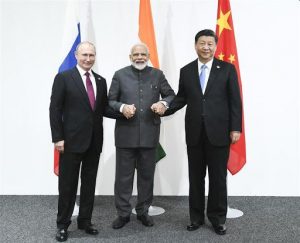
A year is a long time in politics. In 2019, there was excitement and hope. Roman Babushkin, the Deputy Ambassador for Russia in New Delhi declared that “The FTA between India and the Eurasian Economic Union is a priority project for all of us and we are moving towards the early conclusion of the agreement.”
At that time, it was forecast that (https://www.india-briefing.com/news/india-and-russia-looking-to-triple-bilateral-trade-to-us30-billion-by-2025-21152.html/) India and Russia are aiming to achieve US$30 billion in annual bilateral trade by 2025, an increase on the US$10 billion traded in 2019.
The year 2020 changed much for the world. For India, the excitement was replaced with anxiety, as the coronavirus epidemic caught the country napping. It could have shut down flights in the last two months of 2019 but waited till March. By then, the pandemic was causing economic havoc in India. The savage national lockdown made things worse. The year 2021 brought hope that the epidemic was finally over, only to catch India, unprepared once again, with the second wave which caused many more deaths and infections.
Russia rescues India again
Once again, India looked to its old historical ally, Russia, for helping it out. Russia started moving its vaccine Sputnik V – a far more effective vaccine than many others available worldwide. Belatedly, the government began clearing the decks for Indian collaborations with Russia for making the vaccine in this country.
It was a kind of hearkening back to the 1950s and ‘60s when Russia was the only country that helped India with military technology (it still does) and helped it with its first pharma plants (IDPL), steel plants (SAIL) and even locomotive plants. In fact, most of the pharmaceutical entrepreneurs in India acknowledge the immense role of Russia in sharing their expertise with Indians.
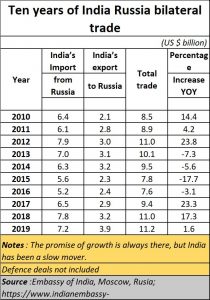 Even today, almost 60% of India’s defence equipment is based on Russian technology. India is now producing the BrahMOS missiles with Russian knowhow, and they are reckoned to be the best in the entire world. Both countries have begun working towards producing SU-30 aircraft and T-90 tanks in India. There are reports that both countries will also manufacture jointly AK-203 rifles, involving full technology transfer. Russia has also agreed to sell to India its formidable S-400 missile system – providing India with a sophisticated anti-aircraft weapon.
Even today, almost 60% of India’s defence equipment is based on Russian technology. India is now producing the BrahMOS missiles with Russian knowhow, and they are reckoned to be the best in the entire world. Both countries have begun working towards producing SU-30 aircraft and T-90 tanks in India. There are reports that both countries will also manufacture jointly AK-203 rifles, involving full technology transfer. Russia has also agreed to sell to India its formidable S-400 missile system – providing India with a sophisticated anti-aircraft weapon.
Russia remains the biggest support for transfer of technology to India, unlike many Western countries, which talked of technology transfer, but only gave this country boxes to assemble with screwdriver, but never parting with source codes or genuine technology transfer.
A resolve to grow together
Today, if you ask government spokesmen on both sides, the old resolve still remains. Both talk of boosting bilateral trade to $30 billion by 2025. Both talk about galvanising invests into each other’s territories. As the government put it (https://www.indianembassy-moscow.gov.in/overview.php) Russian investment in India in 2017 has reached $18bn. India’s total investment in Russia is around $13 bn. In fact, the overall investment (not trade) target of 30 bn USD that was set for 2025 has been already crossed.
The cumulative Indian investments in Russia, (bulk of which is in hydrocarbons sector) was about US $ 8 billion for the period 2000-2014, while the cumulative Russian investments in India over the same period were about US $ 4 billion, mainly in automotive (KAMAZ) and telecommunications (AFK Sistema) sectors. At present there is a resolve to try and increase bilateral investments, especially in the hydrocarbon sector. Some of the priority sectors for investment that have been identified are hydrocarbons, power, coal, nuclear power, fertilizers, IT, mineral and metallurgy, steel, pharmaceuticals, infrastructure projects amongst others.
In the current year, expect more investments in the pharma sector, as India seeks to ramp up its vaccine production capacities with Sputnik V.
Diversification required
Adds India’s Foreign Secretary Harsh Vardhan Shringla –India and Russia should diversify their trade basket and economic exchanges by going beyond the traditional sectors and cooperating in new areas like railways, transport and logistics, pharmaceuticals, minerals, and steel that will add momentum to the bilateral ties. He stated this while speaking at a meeting speaking at a meeting hosted by the Russian Ministry of Foreign Affairs in Moscow in February 2021. “Last year there was a slump, but we are finding ways of reviving it. Both countries have set the bilateral trade target at US$ 30 billion by 2025,” he said.
One of the steps taken to enhance trade is the commencement of negotiations in August 2020 for the India-Eurasian Economic Union (EAEU) Free Trade Agreement. This agreement includes Armenia, Belarus, Kazakhstan, Kyrgyzstan, and Russia and occupies a geographic space between China and the European Union. It has a market of 175 million people and a GDP of $5 trillion. Such an FTA would open markets in Central Asia to Indian businesses. The development of a BRICS digital currency was also discussed.
Shringla pointed out that even though oil exploration had been a key sector for commercial cooperation, both countries have been looking at new avenues. India, for instance, has been looking at coking coal, timber, and LNG.
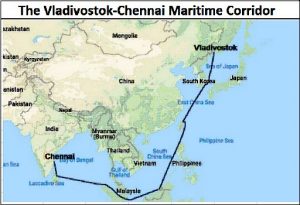 “We have already started a shipping line between Vladivostok and Chennai (https://www.russia-briefing.com/news/russia-india-trade-to-get-back-on-track-with-the-chennai-vladivostok-maritime-corridor.html/). We are looking at a significant trade route which was never there, a new route between our two countries.”
“We have already started a shipping line between Vladivostok and Chennai (https://www.russia-briefing.com/news/russia-india-trade-to-get-back-on-track-with-the-chennai-vladivostok-maritime-corridor.html/). We are looking at a significant trade route which was never there, a new route between our two countries.”
To date, Indian oil and gas companies have acquired stakes in five Russian companies/projects at a value of about US$15 billion. Rosneft was the leader of a consortium of investors that, in 2017, acquired a 98 percent stake in India’s Essar Oil at a cost of US$12.9 billion. Shringla said that India is privatizing its major oil companies, and some are having discussions with their Russian counterparts to see if some of these stakes can be acquired by Russian investors.
“We are looking at long-term arrangements for the supply of coking coal from Russia for Indian steel plants. An India Energy Centre will be opened in Moscow next month,” he said.
Underlining the importance of diversifying and expanding India-Russia trade he said, there is interest in taking forward cooperation in railways, transport and logistics, civilian ship building and repair, inland waterways, pharmaceuticals and medical devices, minerals, steel, chemicals, including petrochemicals, ceramics, agro-industry, timber, high technology, and scientific research. Indian companies are actively exploring investments in Russia in energy, minerals, infrastructure, and healthcare, he said.
Acknowledging that the COVID-19 pandemic revealed several chokepoints and vulnerabilities in global supply chains, he said this has allowed India and Russia to analyse where they can stand together to overcome over-dependence and over-reliance on certain economies.
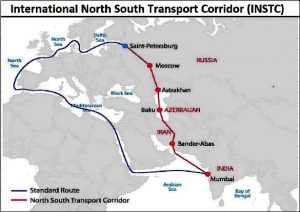 He said India and Russia have prioritized the International North-South Transport Corridor and the Eastern Maritime (Chennai-Vladivostok) Corridor as alternatives to the limited and expensive traditional routes.
He said India and Russia have prioritized the International North-South Transport Corridor and the Eastern Maritime (Chennai-Vladivostok) Corridor as alternatives to the limited and expensive traditional routes.
In the long term, as this author has constantly been saying, the best case scenario for India is to have Russia, China and India working together (http://www.asiaconverge.com/2014/06/russia-india-china-is-the-magic-formula/). The complementariness among the three is tremendous. As the centre of gravity of global commerce moves eastwards, the sooner these three countries come together, the better for all the three.
Russia knows this quite well. It has a pipeline for transporting gas and oil to China and that has helped both countries derisk themselves from the caprices of the west, and the precociousness of 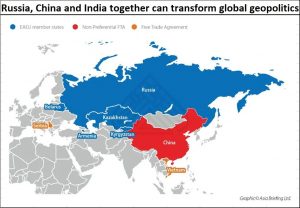 the Middle East. Now Russia and China have begun working on a canal to take water from Lake Baikal – the largest freshwater lake in the world (Russia has the largest fresh water reserves globally) to the heart of China. The latter is water starved. Thus, Russia and China have already begun working together. Now it remains for India to join the trio for mutual benefit.
the Middle East. Now Russia and China have begun working on a canal to take water from Lake Baikal – the largest freshwater lake in the world (Russia has the largest fresh water reserves globally) to the heart of China. The latter is water starved. Thus, Russia and China have already begun working together. Now it remains for India to join the trio for mutual benefit.
Russia could be the marriage maker. Its role in rescuing India can never be underestimated.










































COMMENTS